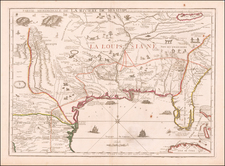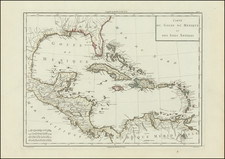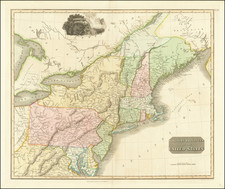Striking example of De Vaugondy's edition of the seminal Fry-Jefferson map.
A well executed reduction of the famous 4 sheet map of the region, which was originally issued separately and later appeared in Jefferys' American Atlas. The result is a beautiful single folio sheet example of the most sought after and recognizeable 18th Century map of Virginia and Maryland. While the title is in French, virtually the entire map is English. The map provides a fabulously detailed look into pre-revolutionary war Virginia and Maryland, extending west to the Alleghany Mountains, and including Delaware and a portion of New Jersey, as well as the region around Philadelphia.
There are 5 states of the map, plus unrecorded variants not noted by Pedley. The present example is state 3 of the map, based upon Pedley. The means for dating the map is as follows: The "Limites de Lord Fairfax" line appears in the first state only. The boundary of Virginia is extended to the Western edge of the map beginning with state 2. "Grave E. Haussard" is removed and the name "Groux" is added beginning with state 3. The words "du roi" and "avec privilege is removed beginning with state 4. The date is removed in state 5.
Gilles Robert de Vaugondy (1688-1766) and Didier Robert de Vaugondy (1723-1786) were influential figures in the realm of 18th-century French cartography. Originating from Paris, their contributions to mapmaking were significant during an era of expansive geographical exploration.
Gilles Robert de Vaugondy entered the world of cartography not through family tradition but through personal interest and the budding opportunities of his time. Born in 1688, he worked during a time when Paris was becoming a central hub for cartographic activities. Gilles often incorporated the latest findings from explorers into his maps, making them sought-after for their contemporary relevance. His connections weren't limited to his immediate circle; he frequently interacted with other key mapmakers, staying updated on the latest techniques and findings.
His son, Didier, was born in 1723 and had the advantage of growing up surrounded by maps and globes. While his father was renowned for maps, Didier made a name for himself in the field of globemaking. His globes were some of the most precise and detailed in France, gaining recognition even among the royalty. In addition to his work in cartography and globemaking, Didier had a keen interest in education, especially after the expulsion of the Jesuits from France. He stepped in to produce geographical educational materials, fulfilling a newfound need.
The maps and globes produced by the Vaugondys remain an enduring testament to the peak of French cartography during the Enlightenment. Their works, characterized by precision and the inclusion of contemporary findings, helped to shape our understanding of the world during a transformative period in European history.

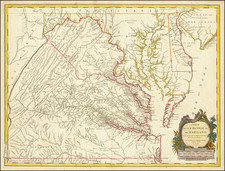








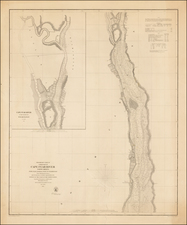
![[Rare Blaeu West Indische Pascaert Wall Map Section] Insulae Americanae in Oceano Septentrionali, cum terris adjacentibus](https://storage.googleapis.com/raremaps/img/small/75672.jpg)
![[ Virginia Native Americans: The manner of making their boats ] Lintrium conficiendorum ratio](https://storage.googleapis.com/raremaps/img/small/97886.jpg)
